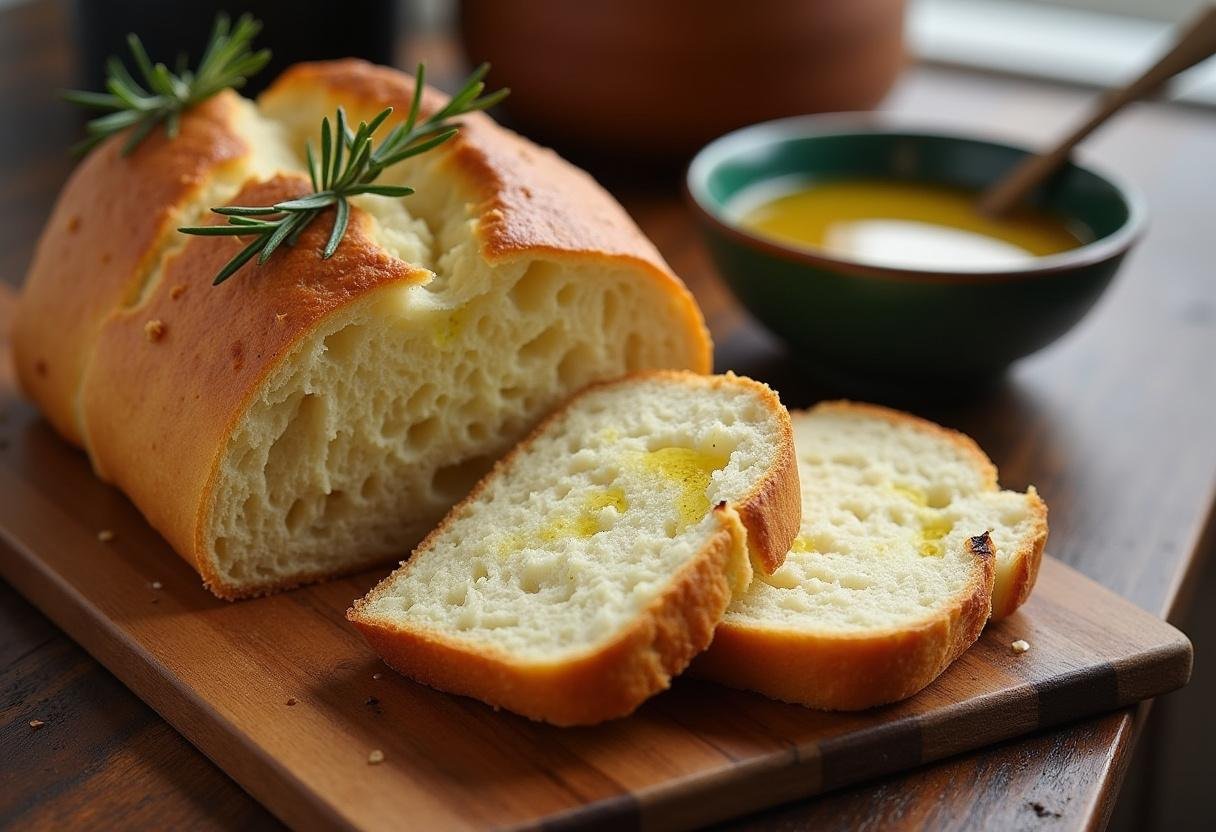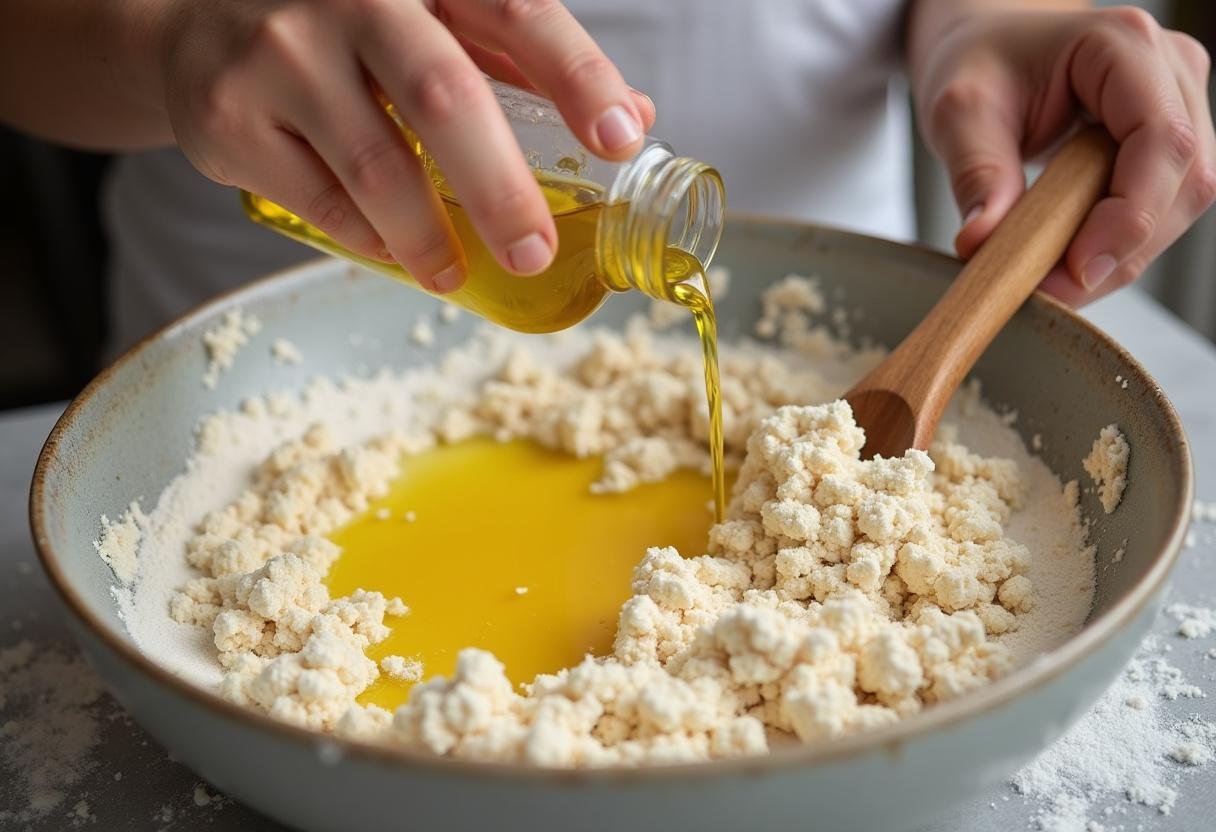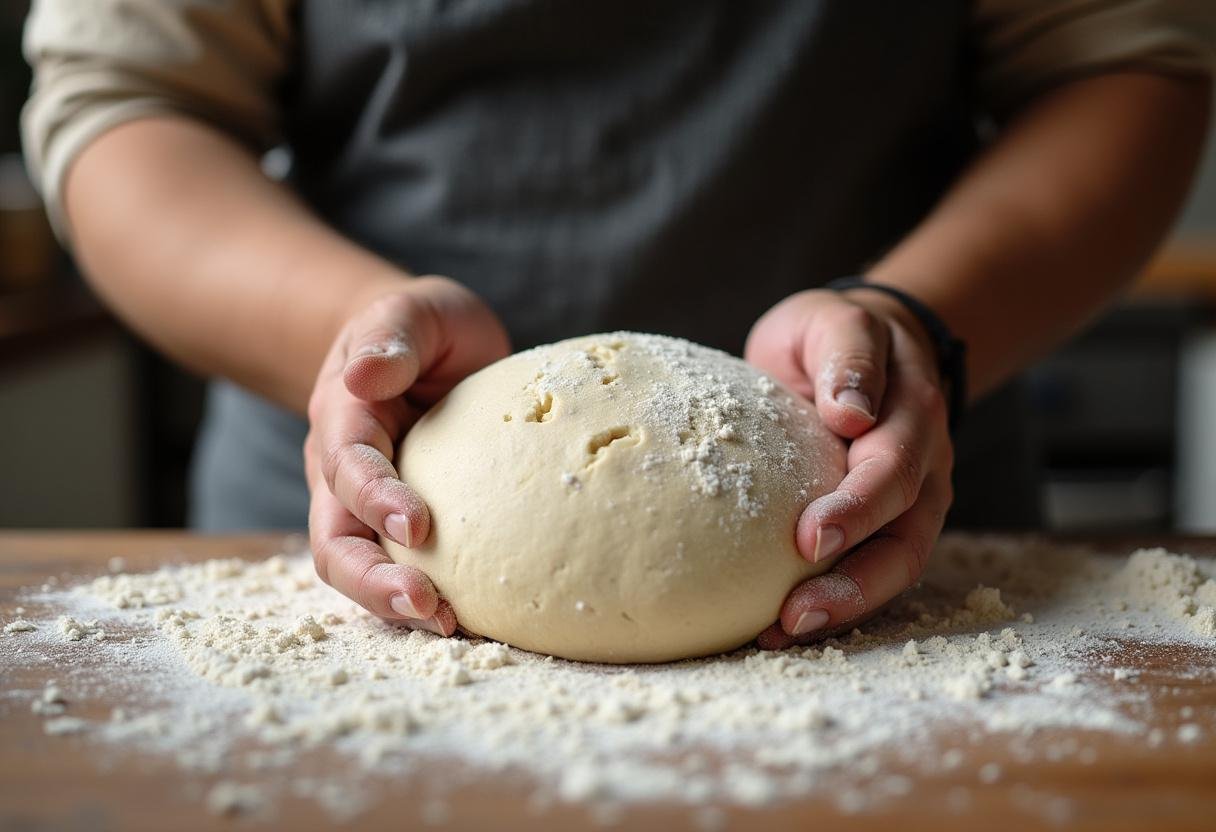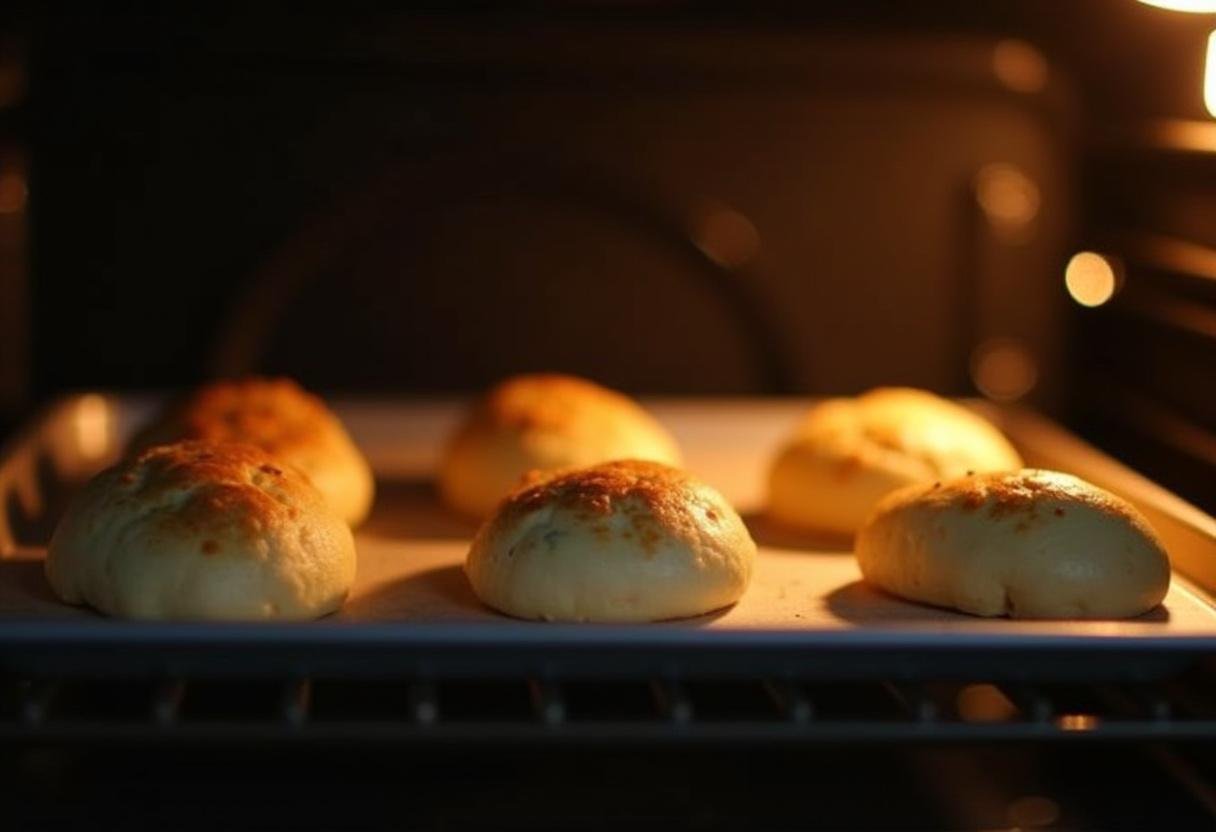Savory Irish Soda Bread with Rosemary and Olive Oil: A Rustic, Flavorful Masterpiece 🍞🌿✨
1. Introduction
There’s something magical about the aroma of freshly baked bread filling your kitchen, especially when it’s this simple yet sophisticated Savory Irish Soda Bread. Unlike traditional yeast breads that require hours of rising, this quick Irish soda bread comes together in about an hour from start to finish. The combination of fragrant rosemary and fruity olive oil transforms the humble soda bread into something truly special – perfect for everything from weeknight dinners to holiday gatherings.
Irish soda bread has been a staple in Irish households for centuries, dating back to the 1800s when baking soda became widely available. This version maintains the rustic charm of the original while adding contemporary flavors that will impress even the most discerning palates. Whether you’re a seasoned baker or just starting out, this easy homemade soda bread recipe is foolproof and delivers incredible results every time.

2. Ingredients
Gathering quality ingredients is key to making the best Irish soda bread. Here’s what you’ll need for this savory version:
- 4 cups (500g) all-purpose flour – The foundation of our bread. For a healthier twist, you could substitute up to half with whole wheat flour.
- 1 teaspoon baking soda – The leavening agent that gives soda bread its characteristic rise and texture.
- 1 teaspoon salt – Enhances all the flavors in the bread.
- 2 tablespoons fresh rosemary, finely chopped – The star herb that gives this bread its distinctive aroma. Fresh is best, but you can use 1 tablespoon dried rosemary in a pinch.
- 1 ¾ cups (420ml) buttermilk – The acidity reacts with the baking soda to create lift. No buttermilk? See our FAQ section for an easy substitute.
- ¼ cup (60ml) extra virgin olive oil – Adds moisture and a subtle fruitiness. Use the best quality you have for maximum flavor.
- 1 tablespoon honey (optional) – Just a touch balances the savory flavors. Omit if you prefer a strictly savory bread.
For those looking to explore more variations of this classic bread, check out this delicious rosemary cheddar version that adds another layer of flavor with sharp cheddar cheese.
3. Step-by-Step Instructions
Step 1: Prepare the Dry Ingredients
Begin by preheating your oven to 425°F (220°C). This high heat is crucial for getting that perfect crust. In a large mixing bowl, whisk together the flour, baking soda, and salt. The whisking action helps aerate the flour and distribute the leavening evenly – a key step for consistent results in this no yeast bread recipe.
Now add the chopped rosemary. If you love the herb’s aroma, try rubbing it between your palms before adding to release more of its essential oils. The rosemary not only adds flavor but makes this one of the most aromatic homemade Irish soda bread variations you’ll ever make.

Step 2: Combine Wet Ingredients
In a separate bowl or large measuring cup, combine the buttermilk, olive oil, and honey (if using). The buttermilk’s acidity is what activates the baking soda, creating the bubbles that make the bread rise. The olive oil in this savory soda bread recipe serves multiple purposes – it adds moisture, creates a tender crumb, and contributes its own subtle flavors that complement the rosemary beautifully.
Pro tip: If your buttermilk is cold from the refrigerator, let the mixture sit for 5-10 minutes to take the chill off. This helps the dough come together more easily and promotes even baking.

Step 3: Form the Dough
Create a well in the center of your dry ingredients and pour in the wet mixture. Using a wooden spoon or your hands, gently mix until just combined. The key here is not to overmix – a few dry patches are better than overworking the dough, which can make the bread tough.
Turn the shaggy dough out onto a lightly floured surface. With floured hands, gently knead it just enough to bring it together into a cohesive ball, then shape it into a round loaf about 2 inches thick. The traditional round shape isn’t just for looks – it helps the bread bake evenly. For more traditional Irish recipes to pair with your bread, visit MealsMom.com.

Step 4: Bake to Perfection
Transfer your shaped loaf to a baking sheet lined with parchment paper. Using a sharp knife or razor blade, score a deep cross (about 1/2 inch deep) on top of the dough. This isn’t just decorative – it helps heat penetrate to the center of the loaf for even baking and allows the bread to expand properly in the oven.
Bake for 35-40 minutes until the bread is golden brown and sounds hollow when tapped on the bottom. The aroma as this quick Irish soda bread bakes is absolutely intoxicating – the rosemary and olive oil create a fragrance that will have everyone asking when it will be ready!

4. Serving Suggestions
This best savory soda bread is incredibly versatile. Here are some delicious ways to enjoy it:
- Simple elegance: Drizzle with your best extra virgin olive oil and sprinkle with flaky sea salt. The olive oil enhances the flavors already in the bread while adding its own fruity notes.
- Soup companion: Pair with a hearty vegetable soup or traditional Irish stew. The bread is perfect for sopping up flavorful broths.
- Charcuterie addition: Serve alongside cheeses and cured meats for an impressive appetizer spread.
- Breakfast treat: Toast slices and top with avocado or eggs for a satisfying morning meal.
- Sandwich bread: Makes excellent sandwiches, especially with roasted vegetables and hummus or turkey and cranberry sauce.
5. Storage Tips
Like most traditional Irish soda bread, this version is best enjoyed the day it’s made when the crust is at its crispiest and the interior at its most tender. However, you can extend its life with these storage methods:
- Room temperature: Wrap completely cooled bread in a clean kitchen towel or beeswax wrap and store at room temperature for up to 2 days. The towel helps prevent condensation that can make the crust soft.
- Freezing: For longer storage, slice the bread first, then freeze in an airtight container or freezer bag for up to 1 month. Thaw slices at room temperature or toast directly from frozen.
- Refreshing: If your bread has gone slightly stale, sprinkle with water and warm in a 350°F oven for 5-10 minutes to revive it.
6. Variations to Try
One of the beauties of this easy homemade soda bread recipe is how adaptable it is. Here are some delicious variations to keep things interesting:
- Cheesy delight: Add ½ cup grated sharp cheddar or Parmesan cheese to the dry ingredients for extra richness.
- Mediterranean twist: Mix in ¼ cup chopped sun-dried tomatoes and 2 tablespoons chopped Kalamata olives.
- Whole grain version: Substitute half the all-purpose flour with whole wheat or spelt flour for added nutrition and a heartier texture.
- Garlic lovers: Add 1 teaspoon garlic powder or 2 cloves minced roasted garlic to the wet ingredients.
- Seeded loaf: Mix in 2 tablespoons each of sesame seeds, poppy seeds, and flaxseeds for extra crunch and nutrition.
7. Why This Recipe Works
This rosemary olive oil soda bread succeeds because of several key factors:
- The chemistry: The reaction between the acidic buttermilk and alkaline baking soda creates instant lift without yeast, making it one of the quickest breads you can make.
- Moisture balance: The combination of olive oil and buttermilk ensures a moist crumb while still achieving a crisp crust.
- Flavor harmony: Rosemary’s piney fragrance perfectly complements olive oil’s fruitiness, creating a sophisticated flavor profile.
- Texture: Minimal handling keeps the gluten development low, resulting in a tender, slightly crumbly texture that’s characteristic of the best Irish soda bread recipes.
8. Frequently Asked Questions
Q: Can I make this without buttermilk?
A: Absolutely! For each cup of buttermilk needed, you can substitute 1 tablespoon lemon juice or white vinegar plus enough milk to make 1 cup. Let it stand for 5 minutes before using. You can also use plain yogurt thinned with milk to buttermilk consistency.
Q: How do I know when the bread is done?
A: The loaf should be deeply golden brown and sound hollow when tapped on the bottom. An instant-read thermometer inserted into the center should read 190-200°F. If the top is browning too quickly, tent it loosely with foil.
Q: Can I add other herbs besides rosemary?
A: Definitely! Thyme, oregano, sage, or a combination would all work well. Use about 1 tablespoon total of dried herbs or 2 tablespoons fresh. You could also add 2 tablespoons chopped fresh parsley or chives for color and freshness.
Q: Why is my bread dense?
A: Density can result from overmixing the dough, using expired baking soda, or not baking the bread long enough. Make sure your baking soda is fresh (test it by mixing 1/4 teaspoon with vinegar – it should bubble vigorously), mix the dough just until combined, and bake until fully cooked through.
9. Conclusion
This rosemary and olive oil Irish soda bread is more than just a quick bread recipe – it’s a celebration of simple ingredients transformed into something extraordinary. The marriage of fragrant rosemary and fruity olive oil elevates the humble soda bread to new heights, creating a loaf that’s equally at home on a casual family dinner table or as part of an elegant entertaining spread.
What makes this the best Irish soda bread recipe isn’t just its incredible flavor and texture, but its remarkable versatility and foolproof method. Whether you’re an experienced baker looking for a reliable quick bread or a beginner wanting to dip your toes into bread-making, this recipe delivers impressive results with minimal effort.
So the next time you’re craving freshly baked bread but don’t want to deal with yeast and long rise times, remember this savory soda bread recipe. In about an hour, you can have a warm, aromatic loaf that fills your kitchen with irresistible smells and your table with delicious possibilities. Happy baking!


[…] protein, and essential minerals. If you love experimenting with flavors, you might also enjoy our Savory Irish Soda Bread with Rosemary and Olive Oil. These patties are incredibly easy to […]
[…] for this Quick and Tasty Korean-Style Beef Bowl. As an alternative, you might want to explore other bread recipes for a […]
[…] If you’re looking for another delicious appetizer, you may consider some Savory Irish Soda Bread with Rosemary and Olive Oil […]
[…] While the classic chicken pinchos recipe is incredibly delicious just as it is, don’t be even remotely afraid to experiment wildly with countless variations and flavorful additions. Consider adding juicy chunks of fresh pineapple for a subtly sweet touch, or try different and exciting types of colorful peppers to add a spicier kick to the finish. You could also add pretty much any other vegetables that you may like, such as fresh zucchini or even cherry tomatoes. For an even richer and more decadent flavor, you could gently brush the skewers with a small amount of melted butter or olive oil during the final few minutes of grilling. Feel free to get creative and make this fantastic Authentic Puerto Rican Chicken Skewers recipe uniquely your own! For another great savory treat, consider making our Savory Irish Soda Bread with Rosemary and Olive Oil! […]